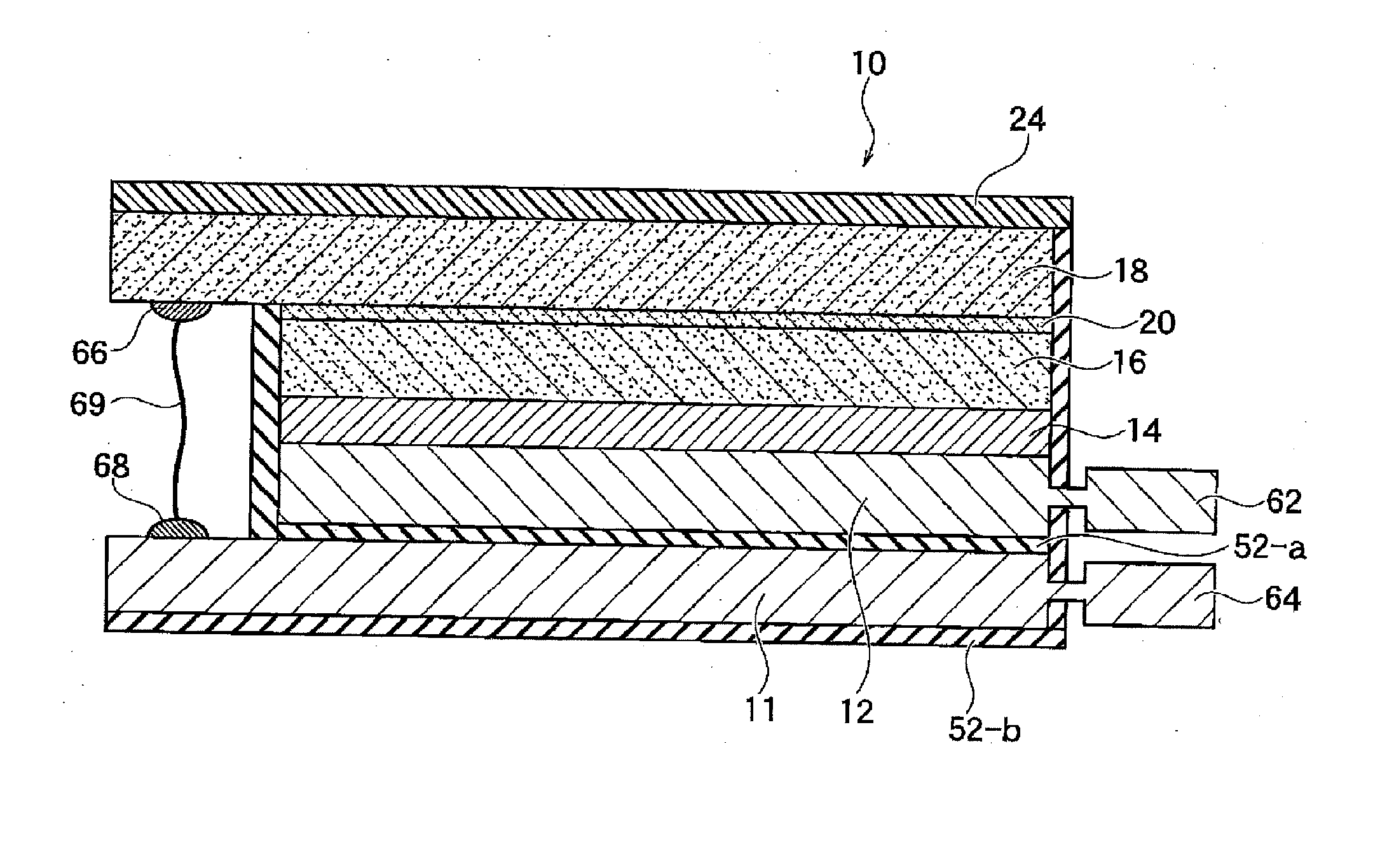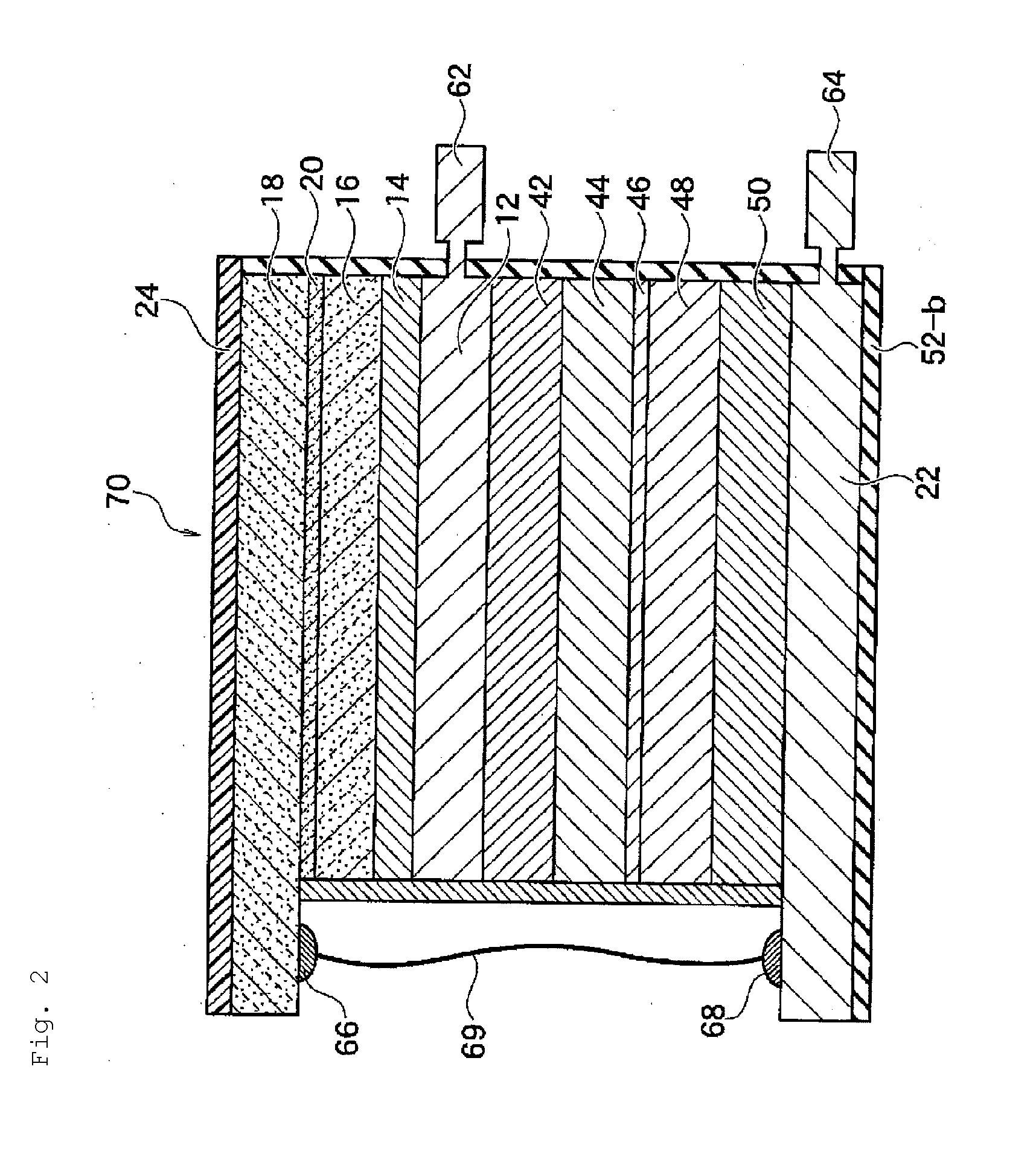Photoelectric Conversion Element, Photoelectric Conversion Element Having Storage/Discharge Function, and Secondary Battery
a technology of photoelectric conversion and storage/discharge function, which is applied in the direction of solid-state devices, climate sustainability, flat cell grouping, etc., can solve the problems of inability to carry out power generation, limited weight reduction, and extremely difficult imparting flexibility, etc., and achieve stably supply power and efficient operation.
- Summary
- Abstract
- Description
- Claims
- Application Information
AI Technical Summary
Benefits of technology
Problems solved by technology
Method used
Image
Examples
example 1
First Step
[0323]In an Erlenmeyer flask having a volume of 300 ml, 50 ml of toluene (C6H5CH3, molecular weight: 92.14) was placed, and 22.2 g of di-2-ethylhexyl sodium sulfosuccinate (C20H37NaO7S, molecular weight: 444.56) was placed therein. The flask was sealed with a rubber stopper to block the outside air, and the contents in the flask were stirred for 10 minutes to completely dissolve di-n-ethylhexyl sodium sulfosuccinate in toluene.
Second Step
[0324]To the toluene solution obtained in the first step, 20 ml of aniline (C6H7N, molecular weight: 93.13) was added, and they were stirred for 5 minutes until the mixture became a homogeneous light yellow solution.
Third Step
[0325]To 180 ml of pure water (H2O) was added 20 ml of hydrochloric acid (37% aqueous solution of HCl) to prepare 200 ml of a hydrochloric acid aqueous solution. While stirring the light yellow solution obtained in the second step by a magnetic stirrer, 150 ml of the above-prepared hydrochloric acid aqueous solution w...
example 2
[0379]Example of production of storage element (secondary battery) in which layer of ferroelectric substance (strontium titanate or the like) coated with ion adsorption substance such as graphene and layer of ion supply substance (e.g., alkali metal salt bonded to graphene) are arranged interposing therebetween solid electrolyte such as vanadate and which utilizes adsorption of ion molecule and charge accumulation of ferroelectric
[0380]Step i
[0381]A quartz cover glass of 18 mm×18 mm was used as a substrate 86, and on the whole surface of the substrate 86, sputtering was carried out using pure copper as a target to form a sputtered film having a thickness of 100 nm to 500 nm. This sputtered film (copper) becomes a collector electrode (copper) 85 and also becomes an electrode.
[0382]Step ii
[0383]On a surface of the copper sputtered film formed in the step i, a heat-resistant polyimide tape was applied in such a manner that an opening of 5 mm×5 mm was formed, whereby masking was carried...
example 3
[0407]Example of photoelectric conversion element having storage effect in which power generation layer and power storage layer are combined as shown in FIG. 13
[0408]Step a
[0409]A quartz cover glass of 18 mm×18 mm was used as a substrate 98, and on the whole surface of the substrate 98, sputtering was carried out using pure copper as a target to form a sputtered film having a thickness of 100 nm to 500 nm. This sputtered film (copper) becomes a collector electrode (copper) 97 and also becomes an electrode.
[0410]Step b
[0411]On a surface of the copper sputtered film formed in the step a, a heat-resistant polyimide tape was applied in such a manner that an opening of 5 mm×5 mm was formed, whereby masking was carried out.
[0412]Step c
[0413]The substrate obtained in the step (b) was heated to 100 to 150° C., and a p-type organic semiconductor was casted to form a film. The thickness of this p-type organic semiconductor layer 96 was 100 to 500 nm.
[0414]Step d
[0415]A pn-bulk layer material ...
PUM
| Property | Measurement | Unit |
|---|---|---|
| Temperature | aaaaa | aaaaa |
| Electric potential / voltage | aaaaa | aaaaa |
| Metallic bond | aaaaa | aaaaa |
Abstract
Description
Claims
Application Information
 Login to View More
Login to View More - R&D
- Intellectual Property
- Life Sciences
- Materials
- Tech Scout
- Unparalleled Data Quality
- Higher Quality Content
- 60% Fewer Hallucinations
Browse by: Latest US Patents, China's latest patents, Technical Efficacy Thesaurus, Application Domain, Technology Topic, Popular Technical Reports.
© 2025 PatSnap. All rights reserved.Legal|Privacy policy|Modern Slavery Act Transparency Statement|Sitemap|About US| Contact US: help@patsnap.com



